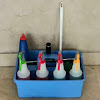To keep the carpet as attractive and clean as possible we should recognize and remedy the following carpet problems.
Pile distortion:
Pile distortion is a general term for several problems with the carpet face fibers. Fibers can become twisted, pulled, crushed or flared, and matted. Pile distortion occurs when the carpet revives heavy foot traffic. improper cleaning methods can also cause pile distraction. Pile distraction is hard to cure. It may be impossible to rectify in high-traffic areas.
Furniture guides can help prevent crushing. Regular vacuuming or using a pile lifter or a pile brush on high traffic areas will help to remove the dry soil, which can wear on fiber and cause pile distortion. A pile lifter will help to pick up crushed piles while removing gritty soil, which can damage the carpet.
Shading:
Shading is a normal feature of almost all carpets. Vacuuming or pile lifting the carpet in one direction can help to reduce a shading problem but probably will not eliminate it.
Fading :
Every carpet will fade with time. Sunlight, wear, cleaning, and natural aging can combine to accelerate color loss. Premature fading may occur if the carpet is not cleaned properly. Improper cleaning or spot remover can do more damage than some permanent stains. Always pretest carpet before using aggressive spot-removal techniques.
Wicking:
Wicking is called browning, it occurs when the backing of the carpet gets wet and the face yarns draw or wick the moisture and color of the backing to the surface of the carpet.
Wicking occurs most frequently in the jute-backed carpet that has a light color face fiber.
Wicking can often be prevented by promptly attending to the spills and by following proper cleaning procedures that avoid over-wetting the carpet. Vinegar or synthetic citric acid solutions used in post-cleaning treatments or added to certain cleaning chemicals can help prevent or cure browning problems. As always, pretest the application before proceeding with an anti-browning treatment.
Mildew:
Mildew forms when moisture allows molds in the carpet to grow. Mildew can cause staining, odor, and rotting. Natural fibers are especially prone to mildew, but all carpets should be kept dry and or treated with an antibacterial to prevent the problem. Proper cleaning procedures that avoid over-wetting the carpet can help prevent mildew from forming.
Pilling:
Pilling is also called shedding. Short pieces of face fibers are often trapped in the carpet when it is manufactured. As the new carpet is walked upon, these pieces work themselves to the surface of the carpet and can make the new carpet look littered and unkempt. Piling will eventually stop. In the meantime, frequent vacuuming will prevent the carpet from looking littered.
Pilling, often the result of cleaning, can be removed by heavy vacuuming or by gently cutting loose fibers from the carpet with scissors.



Comments
Post a Comment
Please do not enter any spam link in the comment box.